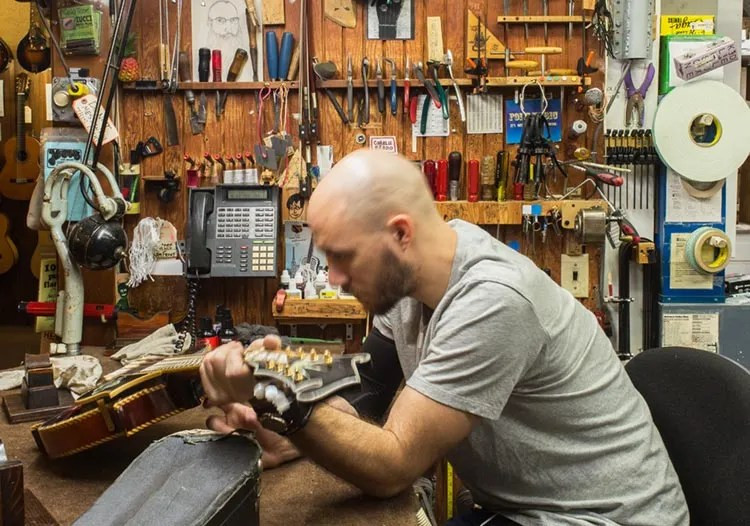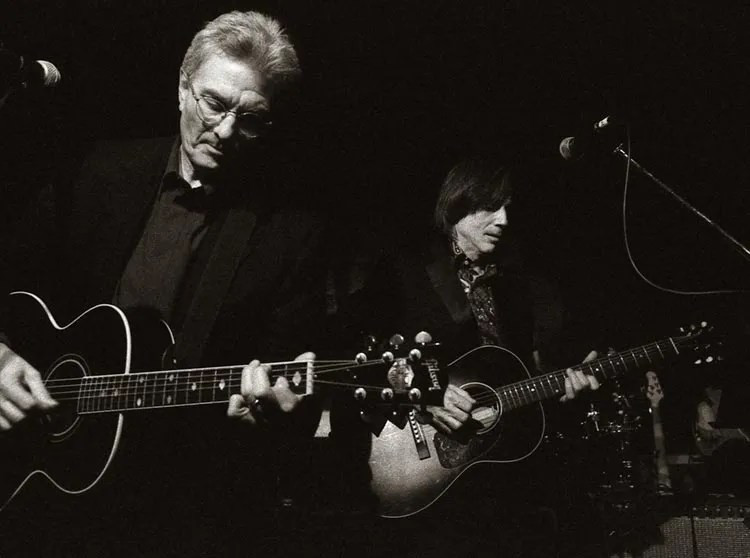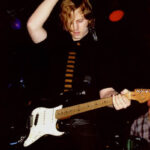Stepping into McCabe’s Guitar Shop at 3101 Pico Blvd. in Santa Monica is like entering a different world, a haven for music enthusiasts that feels more akin to a charming film set than a typical retail space. The iconic guitar-neck door handle welcomes you into a realm where the love of music permeates every corner.
Just inside, a whimsical scene unfolds. Across from a vintage cash register, a mechanical cobbler diligently works on a shoe within a plexiglass enclosure. Overhead, a replica of a fossilized Apatosaurus louisae dinosaur head casts a watchful gaze, while a decommissioned traffic light cycles through its colors. The aroma of complimentary coffee brewing adds to the inviting atmosphere. A whiteboard announces an eclectic mix of classes, from Mali Fingerstyle Guitar to Indian Slide Guitar, hinting at the diverse musical tapestry woven within McCabe’s.
The shop buzzes with a gentle energy. A young musician plucks delicate arpeggios on a Celtic harp, while a small child, barely tall enough to manage a parlor guitar, diligently practices chords. In the open repair department, Matt Bradford, a skilled guitar technician, is engrossed in the delicate process of restoring a classic Gibson archtop. Staff members engage in friendly conversations with customers, and a German public radio crew bustles around, preparing for a live broadcast.
At the heart of this vibrant scene, Bob Riskin, McCabe’s longtime owner, observes with a thoughtful expression. His wife and co-owner, Espie Riskin, joins him, her smile radiating warmth. After a welcoming introduction, they guide visitors into the shop’s inner sanctum, a private room adorned with redwood-paneled walls and showcasing an impressive collection of banjos and Taylor guitars.
 Bob and Espie Riskin, owners of McCabe's Guitar Shop, stand in their renowned store.
Bob and Espie Riskin, owners of McCabe's Guitar Shop, stand in their renowned store.
Folk-Era Roots of McCabe’s Guitar Shop
McCabe’s Guitar Shop isn’t just another music store; it’s a global institution, so legendary that LA Weekly jokingly created a “Best Guitar Shop (That’s Not McCabe’s)” award category. Beyond being a retail destination, McCabe’s is a cherished Los Angeles music venue, a premier spot on the West Coast for acoustic music, a respected music school, and an unofficial community hub for musicians and music lovers alike. It’s a place unlike any other.
The shop’s namesake and founder, Gerald McCabe, was originally a furniture designer. In the mid-1950s, his life took a musical turn through his first wife, folksinger Marsha Berman. Leveraging his woodworking skills, McCabe began receiving requests to repair instruments. In 1958, he established a small shop near McCabe’s current location to serve the burgeoning folk and roots music scene. He enlisted his ethnomusicologist friend, Ed Kahn, to manage books and records, and mentored Walter Camp in the art of guitar repair.
Bob Riskin, son of film director Robert Riskin (director of “It Happened One Night”) and actress Fay Wray (star of the original “King Kong”), grew up in West Los Angeles, close to McCabe’s. He first walked into McCabe’s Guitar Shop as a 16-year-old in 1959. “It was the only guitar store in LA at the time, and except for one employee, Walter Camp, it was practically empty,” Bob recalls, his voice resonating with the history of the shop.
Bob had just acquired his first guitar, a 1912 Martin needing expert repair. He became a regular at McCabe’s, soon becoming an employee, initially sweeping floors and running errands before becoming a repair apprentice. His own Martin became his first repair project. “The Martin was badly damaged, and I learned to repair it piece by piece,” Bob explains. “Then I learned other skills, like hand-scraping rosewood to the right thickness, and I never left.”
The McCabe’s team fostered a welcoming environment by adding a coffee pot, table, and chairs, transforming the shop into a meeting place for local musicians and those passing through. A young Ry Cooder was among the early regulars. “He was only 14, and we already idolized him. He was a musical prodigy—anything you played, he could instantly replicate,” Bob recounts.
“And play it better!” Espie Riskin interjects with a smile.
“That’s when I realized I would never be a musician,” Bob concludes with a laugh.
In the early days of McCabe’s Guitar Shop, Bob and his colleagues had to pioneer their own instrument repair methods due to the lack of resources and standardized guitar maintenance techniques. Necessities that guitarists take for granted today emerged from their experimentation. “We invented countless things, many still used in the industry – like string winders. I used to build them by hand,” Bob mentions. “I even made some excellent picks from cheese, but that’s another story.”
Responding to evolving musical trends, McCabe’s also undertook instrument modifications that would be considered unconventional today but influenced major guitar manufacturers. The 1963 hit “Walk Right In” by The Rooftop Singers sparked a demand for 12-string guitars. With limited 12-strings available, Bob ingeniously converted six-string Martin 00-21s, known for their wider necks. “It was intricate work. We extended the headstocks, ensuring a seamless match, and replaced the bridges. They were fantastic, beautiful-sounding guitars,” Bob recalls, noting that Martin soon followed suit and began producing their own 12-string models.
McCabe’s Guitar Shop flourished in the early to mid-1960s, coinciding with a surge in guitar sales in the US. In 1964, the shop outgrew its original space and moved to 3103 Pico. That year also marked a personal milestone for Bob.
“I met my wife here,” he says with affection.
“He sold me my first guitar,” Espie adds, reminiscing about her Amezcua Guitarra, a Mexican guitar from Paracho.
Espie was the only customer in the store when McCabe asked her to watch the shop while he photographed his furniture. “He said, ‘Here’s the cash register – I’ll be right back.’ Luckily, Bob walked in. And I never left,” Espie recounts, who now manages the shop’s business operations after a successful career in biotech.
“That’s true, and I even got your name wrong— I just made one up,” Bob admits, laughing.
Espie still treasures her Amezcua guitar.
The Accidental Music Venue at McCabe’s
Another serendipitous event occurred in 1969 when folk-blues legend Elizabeth Cotten found herself stranded in LA with a cancelled performance. To assist Cotten in returning home to North Carolina, McCabe’s offered her a stage, despite not having a formal venue. “We created a performance space for her,” Bob explains. “We hung curtains—or maybe plastic bags—on the front window and brought out our teaching chairs for the audience. Her performance was absolutely magical.”
Encouraged by the success of Cotten’s show, and realizing that concerts would necessitate regular cleaning of the perpetually messy shop filled with sawdust and instrument parts, McCabe’s initiated weekly concerts. The intimate space now accommodates 150 attendees. The inaugural official concert featured Bryndle, a local band, with a young Jackson Browne as the opening act. “After that, we never needed to go past La Cienega,” Bob jokes, referring to the route to West Hollywood’s folk clubs, located several miles from McCabe’s.
Over the past five decades, McCabe’s has hosted thousands of artists. Singer-songwriters like Richard Thompson and Joni Mitchell have utilized the venue as a musical testing ground. Guitar icons such as Doc Watson, Merle Travis, Eric Clapton, Chet Atkins, Norman Blake, John Hammond Jr., David Lindley, and John Fahey have graced the stage, alongside jazz luminaries like Sun Ra, Don Cherry, and Charlie Haden. R.E.M. performed at McCabe’s in 1987 at the peak of their popularity, and Beck and Liz Phair played there in the 90s.
 Jackson Browne performing at McCabe's Guitar Shop, a venue he first played as an opening act in 1969.
Jackson Browne performing at McCabe's Guitar Shop, a venue he first played as an opening act in 1969.
David Wilcox, the acclaimed singer-songwriter known for his exceptional guitar skills, reflects on his experiences at McCabe’s: “I’ve played at McCabe’s on my way up and on my way down. The store’s concert tradition is so enduring and fascinating, and being part of it is a lesson in musical history.”
To preserve this rich legacy, thousands of recordings from McCabe’s concert series have been donated to the University of North Carolina at Chapel Hill as part of the Southern Folklife Collection. “They are digitizing them before the tapes deteriorate,” Bob explains.
“I had to catalog them all, one by one,” Espie adds, describing this monumental labor of love.
McCabe’s Guitar Shop: Beyond Retail
Bob became a part-owner of McCabe’s in 1969. Around the same time, Walter Camp departed for Northern California. In 1972, Bob undertook his most ambitious project with McCabe’s, relocating the shop up the street to its current two-story, 6,000-square-foot location, four times larger than the previous space. He shaped it into the iconic McCabe’s Guitar Shop recognized today.
Bob, who became the sole owner when McCabe sold his share in 1986, explains, “I was heavily involved in the design. I influenced almost everything you see in the building, from the layout to wall placements. This redwood paneling, for instance, I designed,” he points out, gesturing to the private room’s wall. “It’s become a signature look for high-end spaces. Years ago, people would visit with cameras, and suddenly, this wooden wall treatment started appearing in the high-end rooms of Guitar Center and Best Buy.”
A glass display case in McCabe’s main room showcases a selection of premium flattop guitars, including a Froggy Bottom parlor and a Martin Custom Shop 00. An adjacent wall features Adirondack-topped dreadnoughts by Collings, among other fine instruments. High-end ukuleles and mandolins are displayed near the ceiling, and various instruments at all price points, including a Wazoo (a kazoo with a megaphone) and a sarod, are scattered throughout the store. “We cater to everyone from beginners to professionals, with a large and diverse clientele in between,” Bob notes.
Aside from unique items like a Gibson Style-U harp guitar above the entrance (not for sale), vintage guitars are notably scarce. Bob explains this pragmatic approach: “We are in a golden age of guitar building. Guitars available today are significantly superior to those commonly made in the 50s, 60s, 70s, or 80s. The improvement in standards is remarkable. ‘Imported’ used to mean low quality, but now, stunning instruments come from overseas factories, and there are so many brilliant independent luthiers.”
Bob leads the way through a narrow hallway lined with affordable ukuleles and student violins, into the back room where concerts are held. Three walls are lined with instruments, from electric guitars to resonators. Stacks of folding chairs are neatly arranged outside a soundproof room. “These are the highest quality folding chairs available,” Bob remarks with a touch of irony.
The back room’s notoriously uncomfortable chairs are offset by its exceptional acoustics. Bob initially consulted sound engineers for the room’s design. An unexpected benefit of the room serving as both a venue and showroom is the sympathetic resonance from the displayed stringed instruments, adding to the room’s natural reverb. Wilcox playfully calls it “string reverb.”
Upstairs, rooms are dedicated to lessons and offices. The hallway is densely decorated with black-and-white photographs of artists who have performed at McCabe’s. “Seeing those photos is both inspiring and humbling,” Wilcox comments. “It feels like a pilgrimage to a place with deep musical history.”
McCabe’s currently has over two dozen instructors offering music lessons. Peeking into a classroom reveals a blackboard illustrating a 12-bar blues progression with chord substitutions, and shelves filled with guitar cases.
“Many people who buy their first guitars here also take lessons at McCabe’s, and some even become teachers here,” Bob explains, highlighting the shop’s role in nurturing musical journeys.
In the corner office of Lincoln Myerson, McCabe’s concert director, Brian Rodriguez, a young employee, works at a computer. An old Stella guitar and an Oscar Schmidt autoharp lean against the wall beside his chair.
“I bought my first guitar here and have been coming back ever since,” Rodriguez shares, echoing a familiar sentiment among the McCabe’s community.

